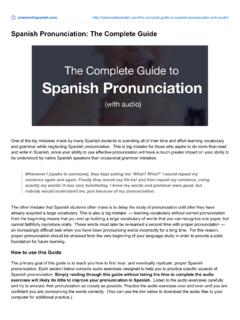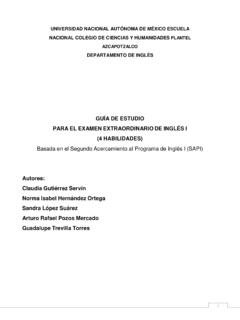Transcription of Guide to Pronunciation - Merriam-Webster
1 Guide to PronunciationPronunciation is not an intrinsic component of the dic-tionary. For some languages, such as spanish , Swahili, andFinnish, the correspondence between orthography andpronunciation is so close that a dictionary need only spella word correctly to indicate its Pronunciation . ModernEnglish, however, displays no such consistency in soundand spelling, and so a dictionary of English must devoteconsiderable attention to the Pronunciation of the lan-guage. The English lexicon contains numerous eye rhymessuch aslove, move,androve,words which do not soundalike despite their similar spellings. On the other hand, italso contains rhyming words such asbreeze, cheese, ease,frieze,andsleazewhose rhymes are all spelled grand mismatch between words that look alike andwords that sound alike does at least serve to record some-thing of the history of the English-speaking peoples andtheir language.
2 Spelling often indicates whether a wordcomes down from the native Anglo-Saxon word stock orwas adopted in successive ages from the speech of a mis-sionary monk chanting Latin, a seafaring Viking dickeringin Old Norse, a Norman nobleman giving orders inFrench, or a young immigrant to turn-of-the-centuryAmerica. For example, the sound \sh\ is spelled asshinnative Englishshore,aschin the French loanchampagne,asskin one Pronunciation of the Norwegian loanski,assiin the Renaissance Latin loanemulsion,and asschin therecent Yiddish vowels present differ-ent complexities of sound and spelling, due in large part tothe fact that William Caxton introduced printing to En-gland in 1476, many decades before the sound changeknown as the Great Vowel Shift had run its course.
3 Withthe rise of printing came an increasingly fixed set of spell-ing conventions, but the conventionalized spellings soonlost their connection to Pronunciation as the vowel shiftcontinued. The stressed vowels ofsaneandsanityaretherefore identical in spelling though now quite differentin quality. For the trained observer the vagaries of Englishorthography contain a wealth of linguistic history; formost others, however, this disparity between sound andspelling is just a continual nuisance at school or often turn to the dictionary wanting to learnthe exact Pronunciation of a word, only to discover thatthe word may have several pronunciations, as is the casefordeity, economic, envelope,andgreasy,among many oth-ers.
4 The inclusion of variant pronunciations disappointsthose who want their dictionary to list one correct pro-nunciation. In truth, though, there can be no objectivestandard for correct Pronunciation other than the usage ofthoughtful and, in particular, educated speakers of En-glish. Among such speakers one hears much variation of English before the modern era usuallyignored Pronunciation variants, instead indicating a singlepronunciation by marking the entry word with diacriticsto indicate stress and letter values. These systems werecumbersome, however, and reflected the dialectal biasesof the editors more than the facts about how a word wasactually spoken. Lexicographers came eventually to recog-nize the need for separate respellings which could recordthe entire range of accepted variants along with appropri-ate notes about dialectal distribution or dictionary records many types of variation in pro-nunciation.
5 Distinctions between British and Americanspeech are frequently noted, as are differences among thethree major dialect areas of the Northern, South-ern, and Midland. Words that have distinctive pronuncia-tions in Canada, such asdecalandkhaki,have those pro-nunciations duly noted. Pronunciations peculiar to certainspheres of activity are also represented, as for example thevariants ofathwartandtackleheard in nautical use. Final-ly, a wide range of unpredictable variations are included,such as the pronunication ofeconomicwith either \e\ or\ \. Unpredictable variations frequently cut across theboundaries of geographical dialects, sometimes runningalong the lines of social class, ethnicity, or gender fine, this dictionary attempts to include either explic-itly or by implication all Pronunciation variants of aword that are used by educated speakers of the pronunciations in this dictionary are informedchiefly by the Merriam-Webster Pronunciation file.
6 Thisfile contains citations that are transcriptions of words usedby native speakers of English in the course of utterancesheard in speeches, interviews, and conversations. In thisextensive collection of3 5 slips of paper, one finds thepronunciations of a host of people: politicians, professors,curators, artists, musicians, doctors, engineers, preachers,activists, journalists, and many others. The merriam webster Pronunciation editors have been collecting thesecitations from live speech and from radio, television, andshortwave broadcasts since the 1930s. It is primarily on thebasis of this large and growing file that questions of usageand acceptability in Pronunciation are answered. All ofthe pronunciations recorded in this book can be docu-mented as falling within the range of generally acceptablevariation, unless they are accompanied by a restricting us-age note or symbol or a regional system of indicating Pronunciation is self explanatory.
7 The following discussion sets out the signifi-cation and use of the Pronunciation symbols in this book,with special attention to those areas where experience hasshown that dictionary users may have questions. More de-tailed information can be found in the Guide to Pronunci-ation in webster s Third New International order of symbols discussed below is the same as theorder on the page of Pronunciation Symbols, with the ex-ception that the symbols which are not letter charactersare here listed first. Those characters which have corre-sponding symbols in the International Phonetic Alphabet(IPA) are shown with their IPA equivalents.\\All Pronunciation information is printed betweenreversed virgules. Pronunciation symbols areprinted in roman type and all other information, such aslabels and notes, is printed in italics.
8 \ \A high-set stress mark precedes a syllable withprimary (strongest) stress; a low-set mark pre-cedes a syllable with secondary (medium) stress; a thirdlevel of weak stress requires no mark at all: \ pen-m n- ship\.Since the nineteenth century the International Phonet-ics Association has recommended that stress marks pre-cede the stressed syllable, and linguists worldwide haveadopted this practice on the basic principle that before asyllable can be uttered the speaker must know what de-gree of stress to give it.\-\Hyphens are used to separate syllables in pro-nunciation transcriptions. In actual speech, ofcourse, there is no pause between the syllables of a placement of hyphens is based on phonetic principles,such as vowel length, nasalization, variation due to the po-sition of a consonant in a syllable, and other nuances ofthe spoken word.
9 The syllable breaks shown in this bookreflect the careful Pronunciation of a single word out ofcontext. Syllabication tends to change in rapid or runningspeech: a consonant at the end of a syllable may shift intoa following syllable, and unstressed vowels may be numerous variations in Pronunciation that a wordmay have in running speech are of interest to phoneticiansbut are well outside the scope of a dictionary of centered dots in boldface entry words indicate po-tential end-of-line division points and not division points are determined by considerations ofboth morphology and Pronunciation , among others. Fur-ther discussion of end-of-line division is contained in thesection of that name within the Explanatory Notes.
10 In thisbook a consistent approach has been pursued, both to-ward word division based on traditional formulas and to-ward syllabication based on phonetic principles. As a re-sult, the hyphens indicating syllable breaks and thecentered dots indicating end-of-line division often do notfall in the same places.\()\Parentheses are used in pronunciations to indi-cate that whatever is symbolized between themis present in some utterances but not in others; thusfacto-ry\ fak-t( -)r \ is pronounced both \ fak-t -r \ and \ fak-tr \,industry\ in-( )d s-tr \ is pronounced both \ in-d s-tr \ and \ in- d s-tr \. In some phonetic environments, asinfence\ fen(t)s\ andboil\ b i(- )l\, it may be difficult todetermine whether the sound shown in parentheses is or isnot present in a given utterance; even the usage of a singlespeaker may vary considerably.

